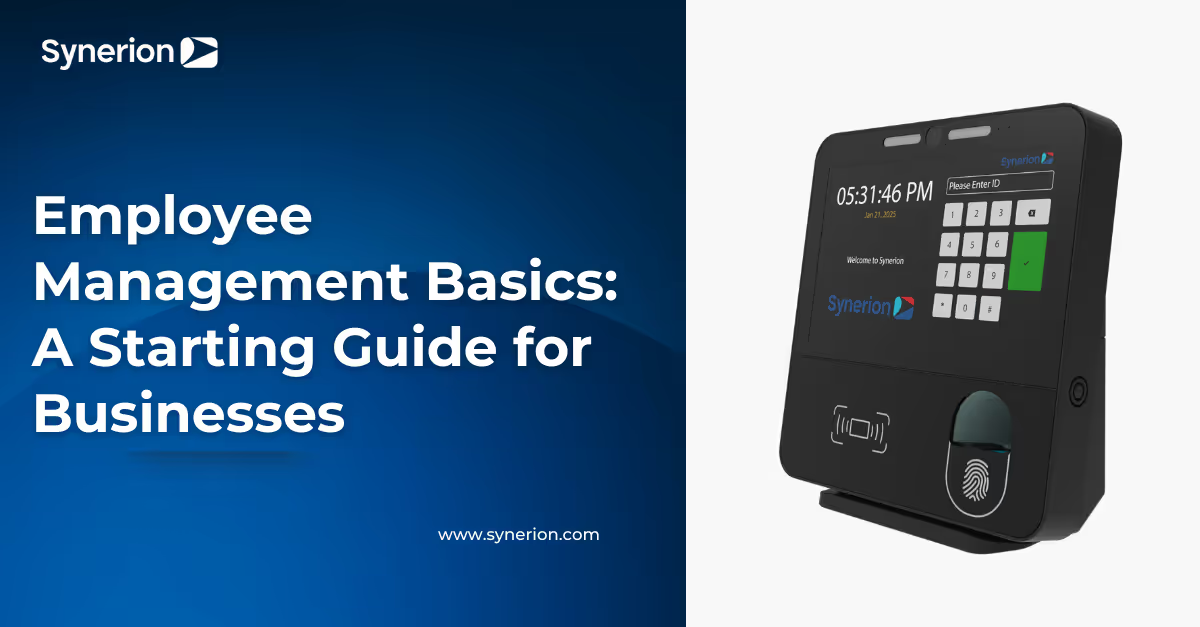
Employee Management Basics: A Starting Guide for Businesses

The difference between thriving businesses and struggling ones often comes down to how well they manage their people. Employee management isn't just about keeping track of hours and assignments; it's about creating systems that bring out the best in the team while driving business results.
Your approach to managing staff directly impacts everything from employee productivity to long-term growth. When you master the fundamentals of employee management, you transform scattered individual efforts into a coordinated force that can take your business to new heights.
This post discusses the basics of employee management and provides a clear path forward for organizations looking to improve their policies and maintain a happy, productive workforce.
Main Takeaways:
- Align employee goals with business objectives to boost engagement and give daily tasks more purpose
- Use workforce management tools to automate time tracking, scheduling, and PTO, saving time and reducing costly errors
- Build strong communication habits through regular 1:1 meetings, real-time feedback, and consistent recognition
- Streamline onboarding with structured plans and early engagement to help new hires ramp up faster
- Embrace mobile tools for managing remote or on-the-go teams with GPS tracking, photo verification, and self-service features
What Is Employee Management?

Employee management is the process of overseeing, coordinating, and optimizing a workforce to achieve business goals while supporting employee development. It encompasses hiring, training, scheduling, and creating policies that guide how employees work together. Effective employee management balances operational needs with employee well-being to create a productive workplace culture.
Modern employment management combines leadership principles with practical tools like workforce management software to streamline operations. The right approach helps you manage employees more efficiently while improving satisfaction and retention.
Aligning Workforce With Goals
One of the key functions of employee management is aligning your team’s efforts with the strategic direction of the business. When employees understand how their work contributes to broader objectives, engagement and performance improve.
- Strategic Alignment: Connect individual performance metrics to business priorities
- Goal Cascading: Translate company objectives into specific team targets
- Regular Reviews: Schedule quarterly check-ins to assess progress
This alignment ensures everyone understands how their daily work contributes to the bigger picture. When staff managers create this connection, employees become more engaged and purposeful in their work.
Maintaining Employee Engagement
Sustaining motivation and commitment is another essential part of managing employees effectively. Engagement directly affects productivity, retention, and workplace morale.
Engaged employees are more productive, provide better customer service, and stay with your company longer, but only 41% of employees are performing optimally, according to a 2023 HR survey.
Build engagement by recognizing achievements and providing growth opportunities, yet only one in three U.S. workers feels they receive adequate praise.
Employee engagement isn't just about staff happiness. It's about creating conditions where people want to give their best effort.
What Responsibilities Does Employee Management Include?
Employee management encompasses everything from talent acquisition to labor cost control. Let’s explore a few key areas that fall under this essential business function:
Hiring and Onboarding
A well-executed hiring strategy creates a strong first impression and serves as the launchpad for sustained engagement and productivity. Crafting compelling job descriptions, targeting the right candidate pools, and conducting rigorous interviews lay the groundwork for a high-performing workforce.
Once the right talent is secured, a structured onboarding process accelerates integration by familiarizing employees with their roles, cultural norms, and performance expectations, reducing ramp-up time and increasing retention.
Scheduling and Shift Planning
Effective shift planning is critical not only to operational continuity but also to workforce satisfaction and retention.
Organizations must balance business demand with employee availability and preferences. Thoughtful scheduling, grounded in both predictive analytics and real-time adaptability, helps minimize absenteeism, reduce burnout, and foster a sense of trust and stability within teams.
Time and Attendance Tracking
Accurate time and attendance tracking is essential for ensuring compliance, maintaining equitable compensation, and managing labor exposure.
Deploying automated systems to capture working hours, breaks, and overtime mitigates the risk of human error and enhances payroll accuracy. These systems also deliver actionable data that informs workforce planning, cost analysis, and compliance reporting.
Leave and Absence Management
A transparent, well-communicated leave policy supports both employee well-being and operational resilience.
Digital leave management systems streamline the request and approval process while providing visibility into workforce availability. When leveraged strategically, these tools ensure adequate staffing, prevent productivity dips, and reduce perceived inequities in time-off practices.
Performance Monitoring and Feedback
Ongoing employee performance evaluation is a cornerstone of organizational growth and development.
Setting clear goals with measurable key performance indicators and providing timely, constructive feedback fosters accountability and supports professional advancement. Embedding a culture of continuous improvement, backed by regular performance reviews and development pathways, helps align individual efforts with broader business objectives.
Labor Allocation and Cost Management
Strategic labor allocation is vital to optimizing productivity while maintaining fiscal discipline.
By analyzing workload distribution, forecasting staffing requirements, and aligning workforce deployment with organizational priorities, business leaders can ensure operational efficiency without exceeding budget thresholds. Effective labor cost management enables informed decision-making and supports long-term financial sustainability.
Why Is Effective Employee Management Important?
Proper employee management directly impacts your bottom line through improved productivity and reduced turnover. When employees receive proper guidance, they perform better and stay longer, reducing costly recruitment cycles.
Enhances Productivity and Business Operations
Strong management practices remove obstacles that prevent employees from doing their best work. By setting clear expectations and providing necessary resources, you help your team accomplish more in less time.
- Streamlined Workflows: Identify and eliminate redundant processes
- Resource Optimization: Ensure employees have the tools they need
- Focus Management: Help teams prioritize high-impact activities
The best employee management approaches emphasize efficiency without sacrificing quality. This balance helps maximize output while maintaining employee satisfaction.
Secures Compliance And Reduces Risks
Proper management of employees helps you navigate complex labor laws and workplace regulations. Staying compliant protects your business from costly penalties and reputation damage.
Maintaining accurate records of hours worked, overtime, and time off is essential for compliance.
Additionally, the SHRM Employee Benefits Survey offers insights on evolving best practices to help ensure legal adherence while supporting employee well-being. Automated workforce management systems can track these details precisely, providing documentation if questions arise.
Core Features Of An Employee Management System

Modern employee management relies on specialized software to automate routine tasks. These systems help with managing time and attendance, scheduling, absence tracking, and labor costs more efficiently.
Time And Attendance Tools
Digital time tracking has replaced manual punch cards in most organizations. Today's systems use biometric verification or mobile apps to record when employees start and end their workday.
- Automated Tracking: Capture work hours accurately without manual entry
- Exception Reporting: Identify attendance issues before they become problems
- Compliance Features: Automatically apply overtime rules and break requirements
These tools are essential for both management employees and frontline workers. They create transparency and accuracy in time reporting that benefits everyone.
Scheduling And PTO Automation
Creating employee schedules manually is time-consuming and prone to errors. Scheduling software helps you build optimal schedules based on business needs and employee availability.
Recruiting And Onboarding Essentials
Effective employee management starts before a new hire's first day. Your recruitment process should identify candidates who align with both job requirements and company culture.
Structured onboarding accelerates productivity by providing new employees with the tools and information they need. Create a consistent experience that includes practical training, policy review, and introduction to company culture.
- Strategic Recruitment: Define clear job requirements and use targeted questions
- Structured Onboarding: Create a 30-60-90 day plan for each new hire
- Early Engagement: Assign a mentor to help new employees navigate your organization
Learning how to manage an employee starts with setting clear expectations from day one. This foundation makes ongoing management much more effective.
Communication And Employee Engagement Strategies
Clear communication forms the foundation of effective employee management. Establish regular channels for sharing information and gathering feedback. Be transparent about business changes to build trust with your team.
Regular one-on-one meetings between managers and employees create opportunities for feedback and problem-solving. These conversations should be structured but comfortable, focusing on both performance and development.
- Structured 1:1 Meetings: Schedule regular check-ins with each team member
- Real-Time Feedback: Address issues promptly rather than waiting for formal reviews
- Recognition Practices: Recognize and reward achievements consistently through multiple channels
Effective communication is essential for any employee-manager relationship to thrive. It creates clarity and prevents the misunderstandings that often lead to performance issues.
Performance Monitoring And Feedback
Modern performance management focuses on ongoing development rather than annual reviews. The Human Resource Management Journal offers leading research on continuous feedback strategies, and regular feedback helps employees adjust their performance in real-time instead of learning about issues months later.
Create SMART goals that provide clarity for performance expectations. These goals should stretch employees' capabilities while remaining achievable with appropriate effort.
- Specific: Define exactly what needs to be accomplished
- Measurable: Include concrete metrics to track progress
- Achievable: Set realistic targets that challenge but don't overwhelm
- Relevant: Ensure goals connect to broader business objectives
- Time-bound: Establish clear deadlines for completion
Mastering Time and Attendance Tracking

Accurate time tracking serves multiple purposes: ensuring proper compensation, maintaining compliance, and analyzing productivity patterns. Modern time tracking solutions balance accuracy with convenience.
Buddy punching, when one employee clocks in for another, costs businesses thousands in unearned wages annually. Biometric verification through fingerprint or facial recognition eliminates this problem by ensuring only the right employee can record their time.
Mobile time tracking apps with GPS verification allow field employees to clock in from job sites. These tools often include offline functionality for areas with poor connectivity and digital forms for capturing job site information.
Optimizing Scheduling And Absence Management

Effective scheduling balances business needs with employee preferences to maximize both productivity and satisfaction. Consider peak business hours, required skill coverage, and employee availability when creating schedules.
Accommodating Shift Premiums
Shift differentials compensate employees for working less desirable hours like nights, weekends, or holidays. These premiums acknowledge the disruption to normal life patterns and help attract staff for these essential shifts.
Integrating Payroll And Labor Costing Solutions
Connecting your employee management system with payroll processing ensures accurate compensation based on actual hours worked. This integration eliminates manual data entry, reducing errors and saving administrative time.
Accurate Data Transfer
Integrated systems create a single source of truth for employee time data. When your time tracking system feeds directly into payroll, you eliminate discrepancies that lead to payment errors.
- Single Source of Truth: Eliminate conflicting data between systems
- Automated Calculations: Handle complex pay rules without manual intervention
- Error Reduction: Prevent common payroll mistakes that frustrate employees
- Audit Trails: Maintain detailed records for compliance verification
These integrations are especially important for organizations with complex compensation structures or union requirements around how time is tracked and paid.
Validating Labor Costs
Labor costing helps you understand where your workforce dollars are going. By tracking time against departments or projects, you gain insights that inform strategic decisions about staffing.
- Department Costs: Identify which areas require the most labor resources
- Project Tracking: Determine the true profitability of different jobs or services
- Overtime Patterns: Spot scheduling inefficiencies that drive up labor costs
Effective management of staff includes understanding not just who works when, but what value that work creates for your organization.
Mobile And Remote Employee Management
Managing remote or distributed teams requires specialized tools and approaches. Mobile workforce management solutions help maintain productivity regardless of employee location.
Time Clock Apps For On-The-Go Teams
Mobile time tracking apps allow employees to clock in from anywhere while providing robust verification features. These tools are essential for field service, construction, healthcare, and other mobile workforces.
- Location Verification: GPS tagging confirms employees are at the assigned location
- Photo Verification: Visual documentation of job site conditions
- Offline Functionality: Ability to track time even without internet connectivity
- Digital Forms: Capture job site information alongside time entries
These capabilities help you manage employees who aren't in a traditional office setting. They provide accountability while giving workers the flexibility they need.
Mobile Employee Self-Service Tools
Self-service apps empower employees to manage their information and requests. This accessibility reduces administrative burden while improving employee satisfaction through greater autonomy.
Mobile self-service typically includes viewing schedules, requesting time off, and updating personal information. These capabilities give employees control over routine matters without requiring manager intervention.
Build A Future-Ready Workforce with Synerion
Modern workforce challenges need powerful, easy-to-use solutions. With 40+ years of experience, Synerion delivers enterprise-level tools at mid-market prices that growing businesses can afford.
Our platform features facial recognition time clocks and connects with over 100 systems. Unlike rigid alternatives, Synerion adapts to your business processes, not the other way around.
Request a demo to discover how we can help you save time, cut costs, and boost productivity.
FAQs
What Types of Tools Are Available for Employee Management?
Common tools for employee management include software for time tracking, scheduling, and payroll, as well as HR systems that handle employee benefits and records. Many HR managers also use platforms for performance reviews, training, and employee engagement. Communication tools like Slack or Teams help keep everyone connected. Together, these tools streamline key HR processes, improve accuracy, and support a more organized, productive workforce.
What Is the Best Employee Management Software on the Market?
The right employee management software depends on your specific business needs, but Synerion is regarded as a leading solution for workforce management, thanks to its comprehensive features and user-friendly interface.
How Do You Choose the Best Employee Management System for Your Business?
To select the right employee management system, compare different options and consider factors such as your business size, industry-specific needs, required features (e.g., scheduling, time tracking, absence management), integration capabilities, ease of use, and scalability. Make sure to request demos (if available).
What Are Employee Management Services, and Are They Worth It?
Employee management services are outsourced solutions that handle HR tasks such as hiring, payroll, compliance, and benefits. They’re often provided by PEOs or HR consultants and can be especially valuable for smaller businesses that lack dedicated HR professionals. These services help reduce admin work, lower compliance risks, and improve efficiency. For growing companies, they can be a cost-effective way to manage HR without hiring additional staff.
